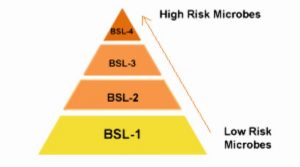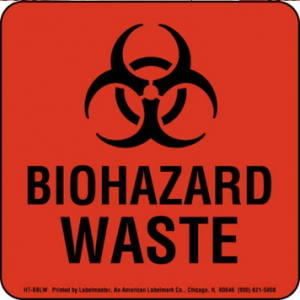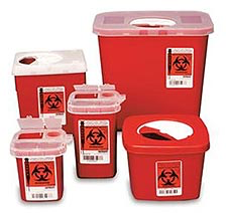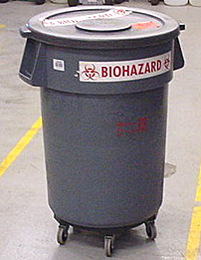Module 1: Laboratory safety
Module 1.2: Biosafety and Biohazardous Waste
Biosafety
The CDC defines biosafety as “the application of safety precautions that reduce a laboratorian’s risk of exposure to a potentially infectious microbe and limit contamination of the work environment and, ultimately, the community.” The laboratory that you will be using for your experiments and procedures is a Biosafety level 2 (BSL-2) laboratory.
What does being a BSL-2 laboratory means to you and your safety?
The Centers for Disease Control and Prevention (CDC) and the National Institute of Health have established four levels of containment called Biosafety levels (BSLs). Each level has specific control measures for the containment of types of microbes and biological agents. The levels are assigned based on the evaluation of specific risks that the microbe or biological material may have on laboratory personnel and the community. The level of containment correlates with infectivity, the severity of disease, transmissibility, and the nature of the work conducted. Other risk factors that may also play in the determination of the BSL level include the origin of the microbe or agent and route of exposure.

The CDC defines containment requirements for BSL-2 as the following:
“If you work in a lab that is designated a BSL-2, the microbes there pose moderate hazards to laboratorians and the environment. The microbes are typically indigenous and associated with diseases of varying severity. An example of a microbe that is typically worked with at a BSL-2 laboratory is Staphylococcus aureus.”
The containment requirements that we are required to abide by including the following.
Laboratory practices
- Access to the laboratory is restricted when work is being conducted.
Safety equipment
- Appropriate personal protective equipment (PPE) is worn, including lab coats and gloves.
- Eye protection and face shields:
- Eye protection must be worn when staff or students are handling risk group 2 (RG2) organisms at the benchtops
- Face shields must be used when performing procedures that may create a splash hazard
- All procedures that can cause infection from aerosols or splashes are performed within a biological safety cabinet (BSC).
- An autoclave or an alternative method of decontamination is available for proper disposal.
Facility construction
- The laboratory has self-closing doors.
- A sink and eyewash are readily available.
Every laboratory, including ours, regardless of the biosafety level follows the standard of microbiological practices. These practices include but are not limited to:
- Not eating, drinking, or applying cosmetics in the lab
- Washing hands after working with infectious materials and before leaving the lab
- Routinely decontaminating work surfaces
Biohazardous waste
In this laboratory, we will be working with BSL-2 agents as part of your learning experience. To ensure everyone’s safety and enjoyable learning environment, we have a rigorous biohazard waste policy.
What is biohazardous waste?
Biohazardous waste, also called infectious waste or biomedical waste, is any waste containing infectious materials or potentially infectious substances such as blood. Of special concern are sharp wastes such as needles, blades, glass pipettes, and other wastes that can cause injury during handling. The waste reciprocals are labeled with the following red biohazard waste label.

1. Sharps container
Each of your benches is equipped with a sharps container. Items that are sharp enough to puncture the skin and contaminated with unsterilized biological material should be placed in these bins.
Examples of items used in our lab that should be placed into the sharps container include:
-

Sharps Containers Glass Pasteur pipettes
- Glass slides
- Biologically contaminated broken glass
If they are overflowing or reaching capacity (3/4 full) please notify an instructor or teaching assistant.
2. Solid non-sharp biohazardous waste
Large biohazardous trash cans are located throughout the lab and are denoted by the large orange biohazardous waste sticker on their sides or lids. Lab consumables that have come in contact with viable biological material that contains any laboratory material that is regarded as potentially infectious should be placed in the bins.
Examples of these types of items that should be placed in the biohazardous bins include:

- Gloves
- Culture flasks
- Plastic pipettes
- Pipette tips and well plates
- Wastes items contaminated with blood or other infectious or biological material
3. Liquid biohazardous waste
In some labs, we will be working with biohazardous liquids, mainly for fecal and urine procedures. On those days, the liquids should be placed in the liquid biohazard waste containers.
Knowledge check
Key Takeaways
- Experiments and procedures are done inside the silver tray on your bench
- The black countertop is your non-procedure/experiment workspace
- We wear approved laboratory attire when in the microbiology laboratory space
- You will be working with BSL-2 pathogens
- If you do not know how to dispose of waste product, please ask.
the application of safety precautions that reduce a laboratorian's risk of exposure to a potentially infectious microbe and limit contamination of the work environment and, ultimately, the community.
also called infectious waste or biomedical waste, is any waste containing infectious materials or potentially infectious substances such as blood.

